Physical Address
304 North Cardinal St.
Dorchester Center, MA 02124
Spontaneous pneumothorax is described as a pneumothorax that occurs in the absence of trauma or significant lung disease. Secondary pneumothorax occurs in the setting of significant underlying lung disease, which predisposes the patient to a pneumothorax. Air in the pleural space typically occurs because of a communication between the lung or the tracheobronchial tree, although it can also occur due to trauma, a significant esophageal rupture, or most rarely a gas-producing organism. As a result of a pneumothorax, there is a decrease in vital capacity of the lung and potentially a decrease in the PaO 2 depending upon the degree of pneumothorax. In young healthy people, this is typically very well-tolerated, but in patients with underlying cardiopulmonary disease, it can be quite physiologically significant. The time required to absorb all gases and the pneumothorax is thought to vary between 1% and 5% in 24 hours. The rate of resorption depends upon most importantly the gas present. Oxygen is absorbed about 60 times faster than nitrogen, whereas carbon dioxide is absorbed about 20 times faster than oxygen. This principal underlies the rationale for temporary administration of supplemental oxygen to patients with a pneumothorax to hasten resorption of the pneumothorax.
Spontaneous pneumothorax is more common in men than in women. The classic characteristic profile is a young, tall, thin man in the second to fourth decade of life. The incidence is approximately 10 per 100,000 population in men and 3 per 100,000 and women. Cigarette smoking also increases the risk of a spontaneous pneumothorax approximately 10- to 20-fold, and the risk increases with the number of cigarettes smoked. The etiology of spontaneous pneumothorax is thought to be rupture of a subpleural bleb and are typically found at CT imaging or surgery in about 80% of patients ( Fig. 1 ). The rate of recurrence after a primary spontaneous pneumothorax is about 25% and is usually within the first or second year after the first episode. The rate of recurrence does increase after each subsequent pneumothorax. Commonly quoted risks are 50% to 60% after the second pneumothorax and even higher after the third. Although the majority of patients have small blebs bilaterally, the risk of contralateral pneumothorax is typically quite low, around 10%.
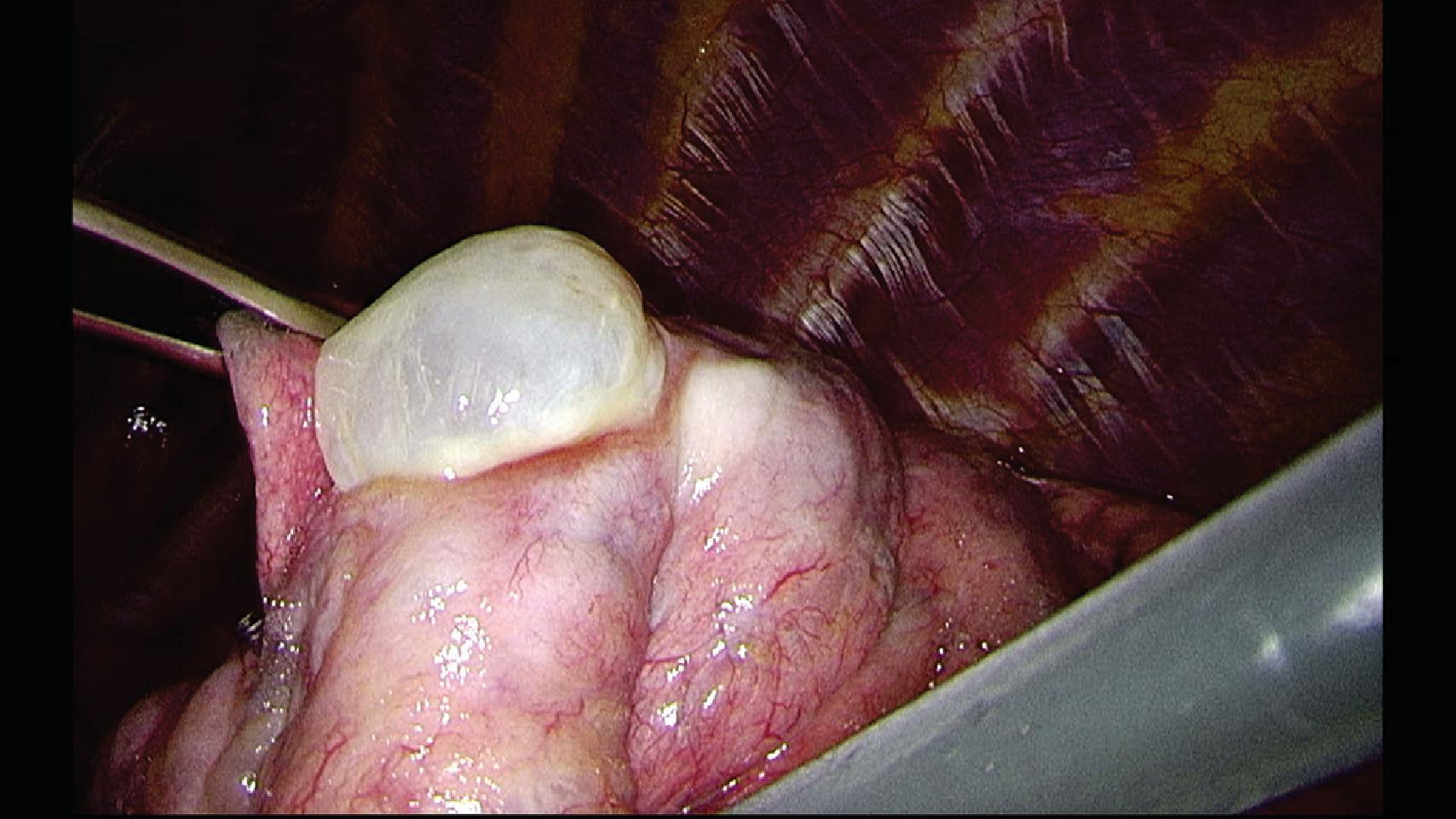
Secondary pneumothorax occurs in patients with underlying lung disease, and this can cause more serious physiologic embarrassment of the patient. The incidence is fairly similar to primary spontaneous pneumothorax. Importantly, however, patients are typically 15 to 20 years older than patients with primary spontaneous pneumothorax largely due to a large number of patients with emphysema ( Fig. 2 ). The risk of recurrence of a pneumothorax with underlying disease is higher than in spontaneous pneumothorax. A large number of potential lung diseases are associated with secondary spontaneous pneumothorax, but of course the most common is chronic obstructive pulmonary disease ( Box 1 ). Although death is extremely rare with primary spontaneous pneumothorax, it is not uncommon for patients with secondary pneumothorax to die because of the underlying significant lung disease. Cystic fibrosis is probably the next most common cause of secondary pneumothorax, typically represents advanced disease, and is a marker of poor prognosis.
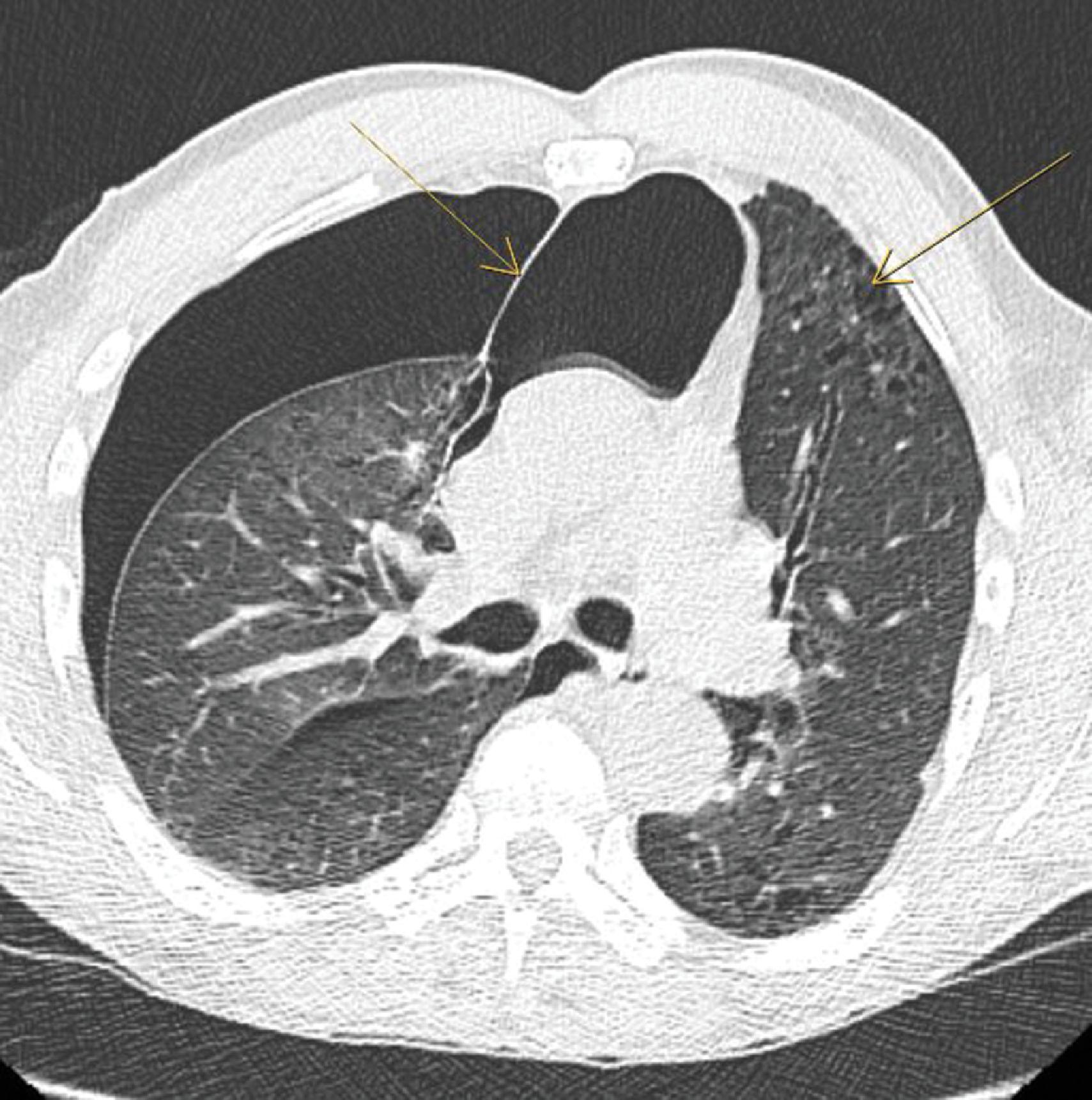
COPD and asthma
Infection tuberculosis
Coccidiomycosis
Pneumocystis jiroveci
Various bacterial pneumonias
Usual interstitial pneumonitis
Lymphangioleiomyomatosis
Sarcoidosis
Lung cancer
Lung metastases (especially sarcoma)
Marfan syndrome
Ehlers-Danlos syndrome
Rheumatoid arthritis
Catamenial pneumothorax
Pulmonary alveolar proteinosis
Pulmonary embolism with infarction
The most common symptom with a pneumothorax is localized sharp pleuritic chest pain, which is usually sudden in onset. This can be associated with dyspnea. Occasionally, a dry cough is present, and patients are rarely asymptomatic. Spontaneous pneumothorax typically occurs in the absence of any significant strenuous exercise or maneuvers that would increase airway pressures. Small to moderate pneumothoraces are typically not identified on physical examination by auscultation. Decreased breath sounds and percussion hyperresonance are occasionally present and can be confused with emphysema. Rarely, subcutaneous emphysema will be palpable in the neck or chest wall. Typically vital signs are normal, but tachycardia may be present in part due to anxiety; severe tachycardia and hypotension and tracheal deviation suggest a tension pneumothorax. If arterial blood gases are done, they may show mild hypoxemia and hypocarbia from hyperventilation.
Typically, a patient with a clinical presentation that suggests a pneumothorax has a chest x-ray performed that will demonstrate a pneumothorax and allow estimation of the severity ( Fig. 3 ). If an initial inspiratory film is negative and the clinical suspicion is high, an expiratory film can be done. Of course, gas tends to collect at the apex with erect posture, whereas supine patients have gas collect anteriorly and the air may be harder to see if the amount is small. Pleural lines need to be carefully sought for, and artifacts need to be excluded such as the edge of the scapula, a skin fold, or clothing. Although there are nomograms to estimate the size of a pneumothorax, most clinicians make a rough guess based on the amount of air in the apex and laterally. A tension pneumothorax is suggested by shift of the mediastinum away from the pneumothorax, depression of the diaphragm, and expansion of the rib spaces.
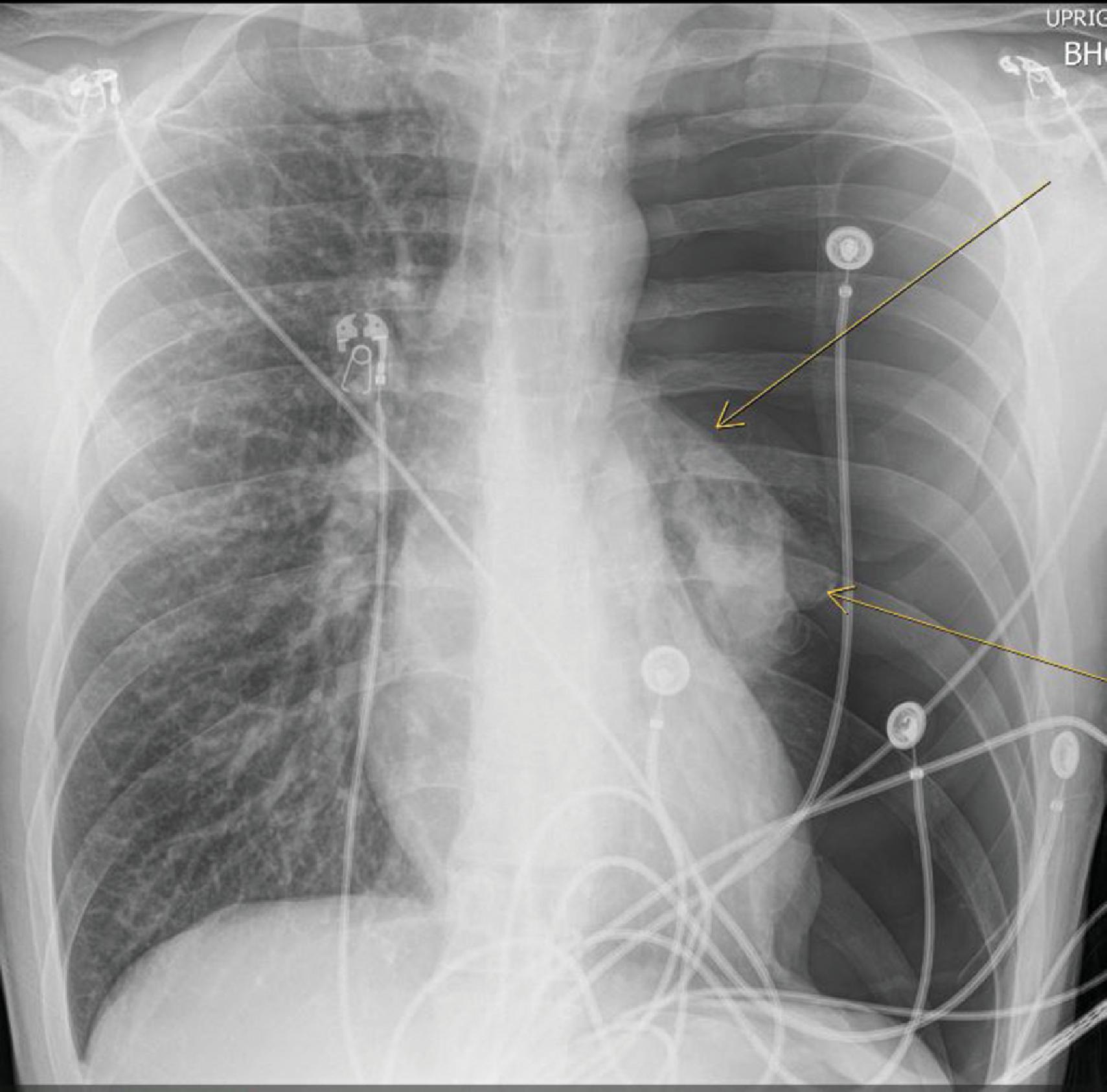
Lung ultrasound is increasingly being used in the emergency room department for rapid diagnosis of a pneumothorax. It is obviously user dependent. Although most commonly used in trauma patients, it is also useful in patients with spontaneous or secondary pneumothorax. In an experienced user’s hands, lung ultrasound is more sensitive than a chest x-ray. Normal lung ultrasound findings including lung sliding with breathing and a granular pattern of aerated lung under the hyperechoic plural line in M mode (Video 1 and Fig. 4 ). A pneumothorax is detected by the absence of lung sliding and the loss of the granular pattern in the lung under the pleural line in M mode (Video 2 and Fig. 5 ).
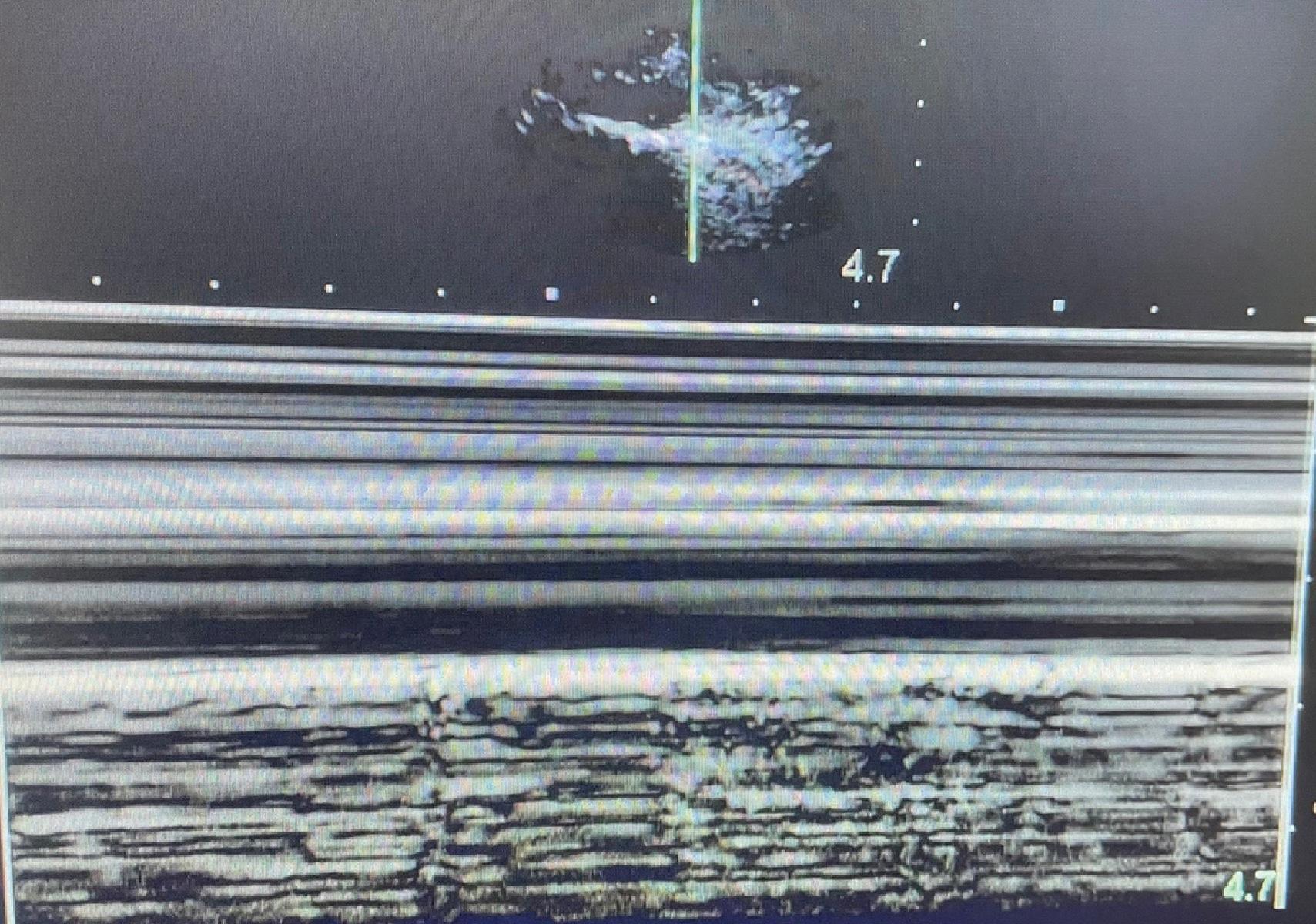
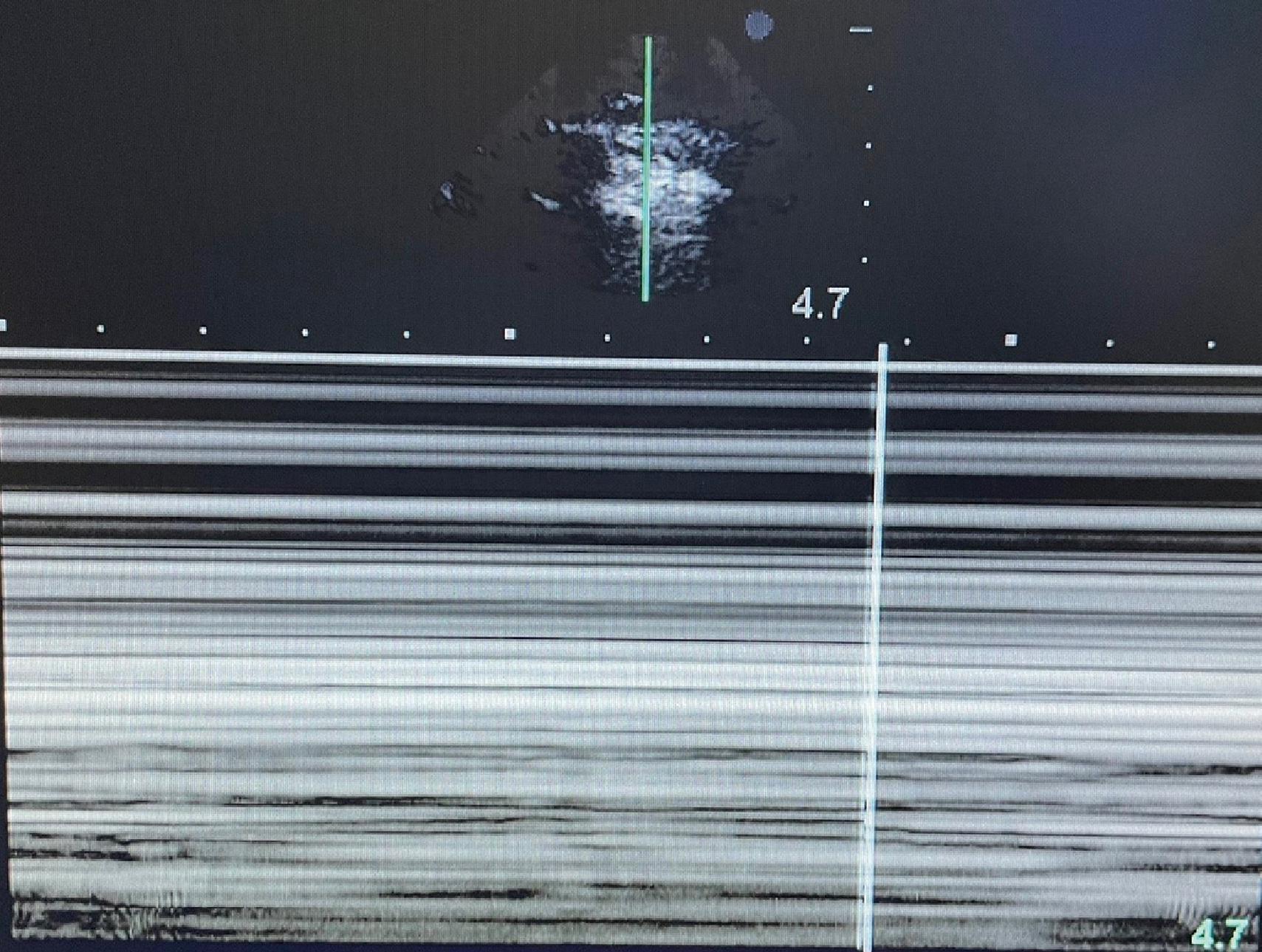
CT scans are now commonly performed in the emergency department when evaluating patients with pneumothoraces. Any underlying lung pathology will be quickly identified, and blebs typically at the apex of the upper lobes can be readily identified. It is not uncommon for a CT scan to identify a pneumothorax that was not seen on a plain chest x-ray, especially in the supine patient. CT scans are most helpful in patients with secondary pneumothoraxes where there is a loculated pneumothorax from areas of pleural symphysis that make it extremely challenging to place non–image-guided catheters to drain the pneumothorax and reexpand the lung.
Although treatment of a pneumothorax is seemingly simple (i.e., placement of a drainage catheter), there are nuances to the management. Factors that weigh into treatment include the size of the pneumothorax, the timing of the presentation of the pneumothorax, the symptoms of the patient, whether it is a primary spontaneous or secondary pneumothorax, and the social aspects of the patient.
Although observation is rarely used in patients with secondary pneumothorax, occasionally healthy patients with spontaneous pneumothorax can be observed as an outpatient or with a brief stay in the emergency room observation area. Patients have to be reliable, have good social support, and be relatively close to an emergency room to be safely observed as an outpatient. The most important aspect of this management is that the patient has a history of a period of self-observation at home where the pain and dyspnea happened perhaps one to several days ago before presenting to the emergency department with a small, now relatively asymptomatic pneumothorax. They have already undergone a period of observation. And clinically it appears that the small leak from the lung has sealed since the pneumothorax has remained small. These patients, if reliable, can be sent home from the emergency department and be seen within the next day or two in the physician’s office for a follow-up x-ray. Obviously if they develop a symptomatic pneumothorax, they are instructed to immediately return to the emergency room for treatment.
Aspiration is a controversial management strategy for a spontaneous pneumothorax. It is essentially never done with secondary pneumothorax. Aspiration does require a period of observation for at least several hours in the emergency department with repeat x-rays before discharge and thus does tie up resources in busy emergency rooms. It is most appropriate for patients who really want to avoid hospital admission with placement of a drainage catheter and again are reliable, well-supported patients. It is helpful if there has been at least some period of the patient tolerating the symptoms of pneumothorax before presentation to the emergency room, which presumably suggests that the air leak has sealed. A chest x-ray should confirm a sizable collection of air in the apex of the chest such that introduction of the intravenous catheter does not injure the anterior surface of the lung when inserted. Typically a 16-gauge or 18-gauge intravenous catheter is inserted after local anesthesia is used in the second interspace costal space anteriorly with a three-way stopcock and a large syringe. The metal inner needle cannula is removed as soon as air is aspirated to avoid injury to the underlying lung. Air is then aspirated through the plastic cannula until no further air can be aspirated. The patient is then observed for a period of several hours and a repeat x-ray done. If there is no recurrence, the patient is discharged again with a follow-up x-ray in 1 to 2 days and instructions to return immediately to the emergency room if symptoms recur. The patient should be seen in the office in a few days.
The classic treatment of the pneumothorax has been the surgical placement of the tube thoracostomy catheter. This is typically done as a bedside procedure with a thoracostomy tray for instrumentation. It can be a painful procedure, and often it is helpful to provide mild sedation with intravenous narcotics and/or benzodiazepines. The typical placement location recognizes that the chest wall muscle configuration allows placement through the least muscle possible below the axilla, between the anterior and posterior axillary lines, which mark the pectoralis muscle anteriorly and the latissimus muscle posteriorly. Typically, the tube is then placed through slips of the serratus muscle, which is thinner.
The area is widely prepped and draped in a sterile fashion. Typically 1% Xylocaine plain local anesthesia is used. Knowledge of the intercostal bundle and its relationship to the undersurface of the rib is important to avoid injury to the intercostal artery or vein. Accordingly, the pleural space is entered on top of the rib, which minimizes the chance of injury to these vessels that lie at the bottom of each rib. After a skin wheal is made, a small transverse incision is made that is at least as large as the catheter that is going to be placed. Additional local anesthesia is then given through this incision to the underlying soft tissue, the rib, and the interspace that is going to be used. The rib is then palpated with a finger to ensure that the surgeon is placing the instrument just on top of the underlying rib. The rib is then palpated with a surgical clamp, typically a Kelly clamp, and once the top of the rib is found, controlled pressure on the clamp is used to enter the pleural space. The clamp is then spread to widen the passageway before the tube is placed. Thereafter, a clamp is used to squeeze and narrow the end of the chest tube; this is placed into the pleural space, and an attempt is made to thread the catheter apically. A technique of ballottement is often used to facilitate placement in the apex as the chest tube can hang up on the fissure of the lung, an osteophyte, or a rib. The surgeon should have a rough indication as to how far the tube should be inserted to reach the apex and should attempt to insert it to that distance. The tube is then connected to a pleural drainage device. The tube is then secured with heavy sutures to prevent dislodgment, and a dry sterile dressing is applied. Vaseline gauze is not used as that can promote infection. Typically, the tube is placed to suction if the pneumothorax was small, but with large pneumothorax it is often helpful to place it to waterseal for a period of time to allow slower lung expansion and avoid the phenomenon of reexpansion pulmonary edema, which is rarely seen. The reexpansion of a significantly shrunken lung often leads to paroxysms of coughing and pain, which the surgeon needs to talk the patient through. The coughing goes away once the lung is totally reexpanded. A chest x-ray is then performed to confirm the position of the chest tube and that the evacuation of the pneumothorax was appropriate. The patient is then monitored for air leakage, and subsequent chest x-rays are done as clinically appropriate. There are some chest tube insertion kits that come with a trocar insertion device. Care must be used when using a trocar technique to avoid inadvertent injury to the heart or lung. These are safe if there is a large pneumothorax and a significant air gap between the lung edge and ribs. If there is any pleural symphysis at the insertion point, lung injury will occur. Alternatively, there are some chest tube insertion kits that have a plastic insertion device that hooks onto the tip of the chest tube and can facilitate chest tube placement with much less possibility of damage to the lung.
In recent years, the numbers of tube thoracostomies have fallen off as the insertion of much smaller catheters that use the Seldinger technique have become very popular ( Fig. 6 ). These catheters were first used many years ago by our interventional radiology colleagues and now have been widely used in emergency rooms, intensive care units, and at the bedside for less invasive chest drainage. The catheters themselves typically have a pigtail shape at the end once the insertion stylette is removed. These catheters are softer and smaller than typical chest tubes and cause less patient discomfort. As long as there is a significant pneumothorax, they are easy to insert. The disadvantage of these catheters is that they have very small diameter, are more easily kinked, and the small holes within the chest can become clogged with serum or blood. Furthermore, if there is a very large air leak, they may not be large enough to adequately evacuate the pleural space. However for most patients with a spontaneous pneumothorax, they are more than adequate.
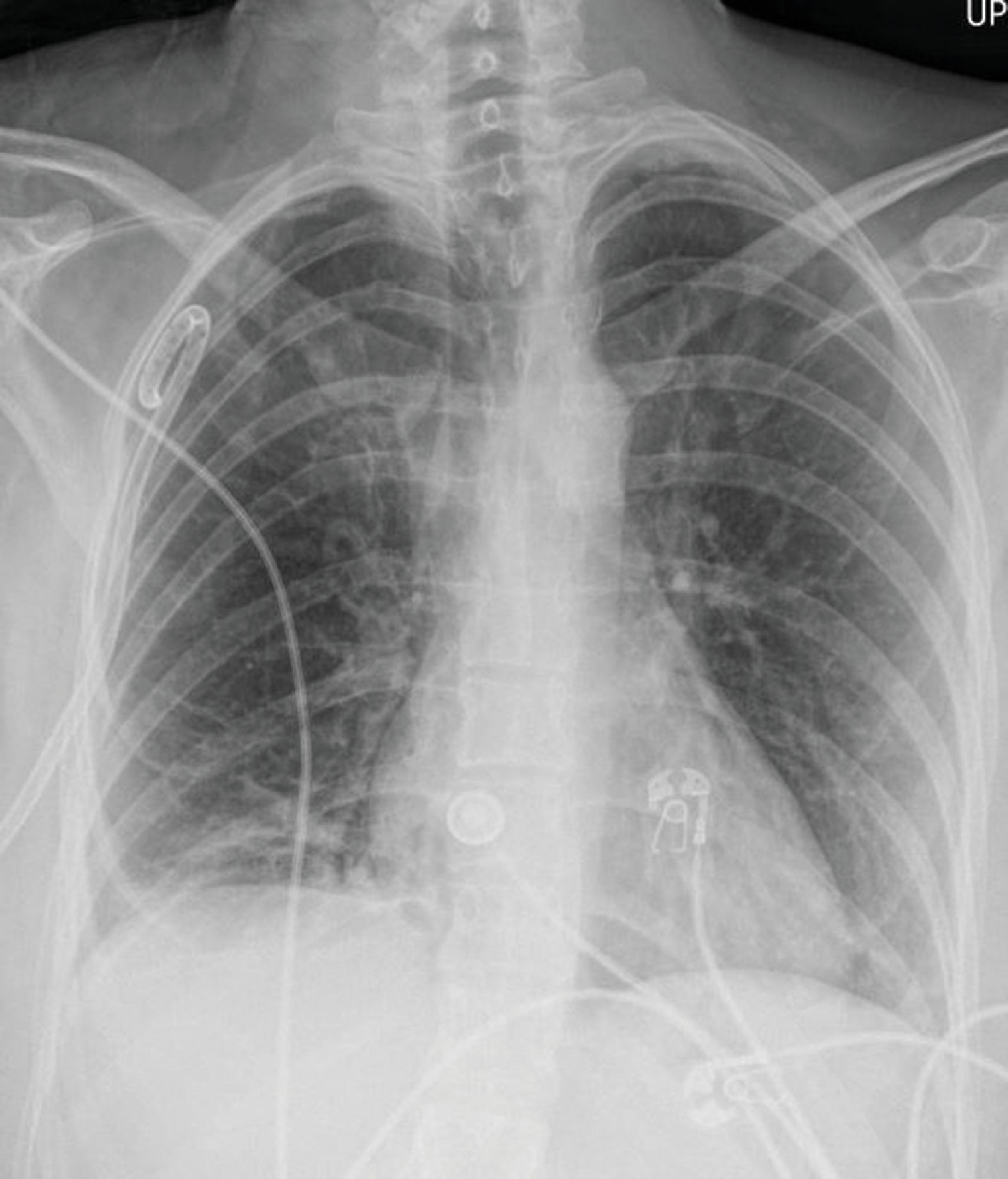
The insertion technique mirrors that of open tube thoracostomy. A sterile field is created, local anesthesia is used, and the needle for the local anesthesia is aspirated for air once it enters the pleural space to confirm a pneumothorax is present, which is amenable to pigtail catheter placement. A guidewire is then passed through the needle, which has a soft flexible tip. A stiff dilator is then typically passed over the wire to slightly widen the insertion site, and then the dilator is carefully removed leaving the wire in place. Thereafter, the catheter is threaded onto the guidewire and advanced into the chest toward the apex. The catheter is then secured with a suture, a dry sterile dressing is applied, and the catheter is attached to a pleural drainage system. The catheter generally should be placed in a similar position as a tube thoracostomy. In men with relatively thin chest walls and an apical pneumothorax, they may be placed in the second intercostal space anteriorly in the midclavicular line. In general, we do not utilize this access point for a woman as it can cause unsightly scarring to the breast area.
The use of these small, less invasive pigtail catheters has led to an increased treatment of spontaneous pneumothorax in appropriate patients as an outpatient. The catheters can be hooked up to a Heimlich valve, a very small drainage collection receptacle that also has a one-way valve, or a small portable complete pleural drainage system that can be attached to a shoulder strap. The patients can then be discharged from the emergency room and seen in the office for follow-up in a couple of days at which time air leaks have usually sealed. An x-ray should have confirmed that the pneumothorax has resolved after pigtail placement, and obviously the patient must be carefully selected so they can safely manage such a device at home.
The goal of the pleurodesis is to cause significant adhesions between the visceral and parietal pleura to obliterate the pleural space. This can seal an ongoing air leak or prevent future pneumothoraxes if the area of pleural symphysis is where a ruptured bleb occurs. Chemical pleurodesis is uncommonly performed for first-time spontaneous pneumothoraces. Chemical pleurodesis is typically performed for recurrent, difficult to control pneumothoraces, especially after a previous operative intervention. Bedside pleurodesis is much more commonly performed with secondary pneumothoraces to avoid operative intervention in patients at high risk for an operative procedure. Typically, a doxycycline solution (500 mg to 1 g) or a sterile talc slurry (4–5 g) is used for bedside pleurodesis. Talc is more effective than doxycycline at creating a pleural symphysis, but there are some concerns about using talc in young people with a spontaneous pneumothorax. Previous versions of talc were not guaranteed to be asbestos-free raising concern for late mesothelioma. However current versions of FDA-approved talc are asbestos-free. In addition, the symphysis caused by talc is usually quite strong, and if the patient was ever to need another thoracic operation, it makes that subsequent operation much more difficult because of the severe adhesions. Obviously, this is a relatively uncommon scenario. Pleurodesis with either these agents typically cause a fair degree of pleuritic chest pain, and the patient should be cautioned about this and pain medicine made available for patient comfort. For pleurodesis to work, obviously there should be relatively complete apposition of the visceral and parietal pleura such that adhesions can form. If the patient has an ongoing air leak, the chest tube drainage system should not be clamped to allow pleurodesis to occur as this could lead to a tension pneumothorax. Typically, after sterilely prepping the drainage system tubing close to the chest tube insertion point, a needle is passed obliquely through the tubing such that it will seal quickly when the needle is removed. A large syringe is then used to inject the sclerosing solution, the needle is withdrawn, and then a clear plastic self-adherent dressing is placed over the insertion point to make sure that is sealed. If the patient has no air leak, the chest tube can be clamped to allow the solution to remain in the chest for 1 to 2 hours. If the patient has an ongoing air leak, the chest tube drainage tubing system can be hooked around an IV pole such that the solution remains in the chest once the injection is complete. There are rare cases of ARDS after talc is used related to both a very small particle size as well as doses over 5 g. For that reason, the typical adult dose is 4 to 5 g of talc. The chest drainage system is then placed on suction, typically for 1 to 2 days at a minimum, to ensure maximum pleural apposition to obtain the best possible pleurodesis.
The advent of minimally invasive surgery for the chest, video-assisted thoracic surgery (VATS), has lowered the threshold for operative intervention for a pneumothorax. The indications for operative intervention are not particularly firm. The clearest indication for operative therapy is a recurrent pneumothorax, a patient with a first-time spontaneous pneumothorax with an ongoing air leak after 2 to 3 days, or the rare patient with a bilateral pneumothorax. Other indications include patients who present with a tension pneumothorax; patients with an identified large bleb; or patients with lifestyle issues such as pilots, scuba divers, or people who travel to areas without access to good medical care. Some patients elect to have operative intervention during the first hospital admission given the recurrence rate, which approaches about one-third, to reduce the chance of a recurrence.
VATS is typically performed under general anesthesia with three small incisions: one for the camera and the other ports for a stapler and forceps. It is, however, possible to do VATS under local anesthesia with sedation in thin, appropriately selected, compliant patients. In addition, uniportal VATS is certainly possible with a slightly larger main incision with this relatively simple surgical procedure. The lung is carefully explored, concentrating on the apex of the upper lobe and the tip of the superior segment of the lower lobe, which is where most blebs occur. Blebs are then typically stapled off with an endoscopic stapler. Most surgeons perform some sort of mechanical pleurodesis with a small gauze sponge, an electrocautery scratchpad, or with an energy device such as an argon beam coagulator. Alternatively, for high-risk patients, an apical pleurectomy is sometimes done, which is the most effective operative pleurodesis technique. However, this comes at the cost of longer operative times, increased risk of bleeding, and a slight risk of injury to adjacent structures such as the intercostal bundle or the stellate ganglion. A drainage catheter is placed after the procedure, and most patients can be discharged in 1 or 2 days. In patients with severe chronic obstructive pulmonary disease (COPD) who are being operated on, there can be significant leakage from the poor-quality lung at the staple line; these can be reinforced with commercially available buttressed staple loads or sealed with commercially available lung sealants. Talc pleurodesis is often used in patients with a secondary pneumothorax secondary to COPD to minimize the chance of recurrence.
A chest wall mass may represent any one of a broad spectrum of entities including benign or malignant primary chest wall tumors; locally invasive tumors originating from the lungs, pleura, mediastinum, or breast; metastatic lesions; and non-neoplastic (infectious or inflammatory) lesions. Of these, primary chest wall tumors, whether benign or malignant, are the least common; they comprise only 5% of all thoracic neoplasms. This creates a diagnostic challenge for surgeons as more commonly seen metastatic lesions must be ruled out. Primary chest wall tumors are best classified according to their tissue of origin and are further subdivided as either benign or bearing malignant potential. In this chapter, we review the most common primary chest wall tumors and focus on surgical management options, including chest wall resection and reconstruction. A list of benign and malignant primary chest wall tumors is provided in Box 1 .
Chondroma
Fibrous dysplasia
Osteochondroma
Lipoma
Fibroma
Neurilemmoma
Eosinophilic granuloma
Aneurysmal bone cyst
Osteoid osteoma
Osteoblastoma
Giant cell tumor
Chondrosarcoma
Osteosarcoma
Liposarcoma
Malignant fibrous histiocytoma
Rhabdomyosarcoma
Angiosarcoma
Fibrosarcoma
Neurofibrosarcoma
Ewing sarcoma, primitive neuroectodermal tumor (PNET), small round blue cell tumor
Plasmacytoma
The vast majority of patients with primary chest wall tumors present with a painless, enlarging mass. Other patients who are entirely asymptomatic may have a primary chest wall tumor detected with thoracic imaging studies performed for unrelated indications. Pain in a patient with a primary chest wall tumor likely represents bony erosion or involvement of adjacent nerves, and it is often a harbinger of malignant tumor behavior. Workup includes a history and physical examination, with attention directed to a history of other malignancies, radiation exposure (therapeutic or environmental), and overt signs of infection or inflammation on physical examination.
A plain film chest radiograph may reveal a soft tissue or bony abnormality. Contrast-enhanced thoracic CT can help delineate the extent of bony, soft tissue, pleural, lung, or mediastinal involvement and can also exclude nodal or pulmonary metastatic disease. Contrast-enhanced MRI can help delineate vascular or nerve involvement. A freely mobile mass less than 2 cm in size can generally be excised with clear margins, with both diagnostic and therapeutic intent. In contrast, larger lesions or those that are fixed to the underlying bone or soft tissue should undergo core needle biopsy or open incisional biopsy before definitive resection. Care must be taken to plan these biopsies with a subsequent curative resection in mind, with incisions placed appropriately so as not to preclude subsequent complete resection as indicated. Tissue diagnosis before surgical resection can help exclude infectious or inflammatory lesions for which resection may not be indicated, and it may allow for neoadjuvant radiation or chemotherapy, when appropriate, if the lesion is malignant.
The most common benign bony tumor of the chest wall, fibrous dysplasia represents a lesion in which normal marrow and cancellous bone is replaced with a fibrous stroma ( Fig. 1 ). It typically presents as a painless mass of the rib, commonly located posteriorly or laterally on the chest wall. Radiographic findings are variable but often include a central ground-glass appearance with punctate calcifications and peripheral cortical thinning. These tumors most commonly present as a solitary lesion in otherwise healthy individuals 20 to 30 years of age. They can, however, be multiple and are associated with McCune-Albright syndrome, which includes cutaneous manifestations and endocrine abnormalities in the context of short stature and precocious puberty. Surgical therapy is only indicated if the diagnosis is in doubt or if the lesion is symptomatic. In such cases, limited partial rib resection is the definitive treatment.
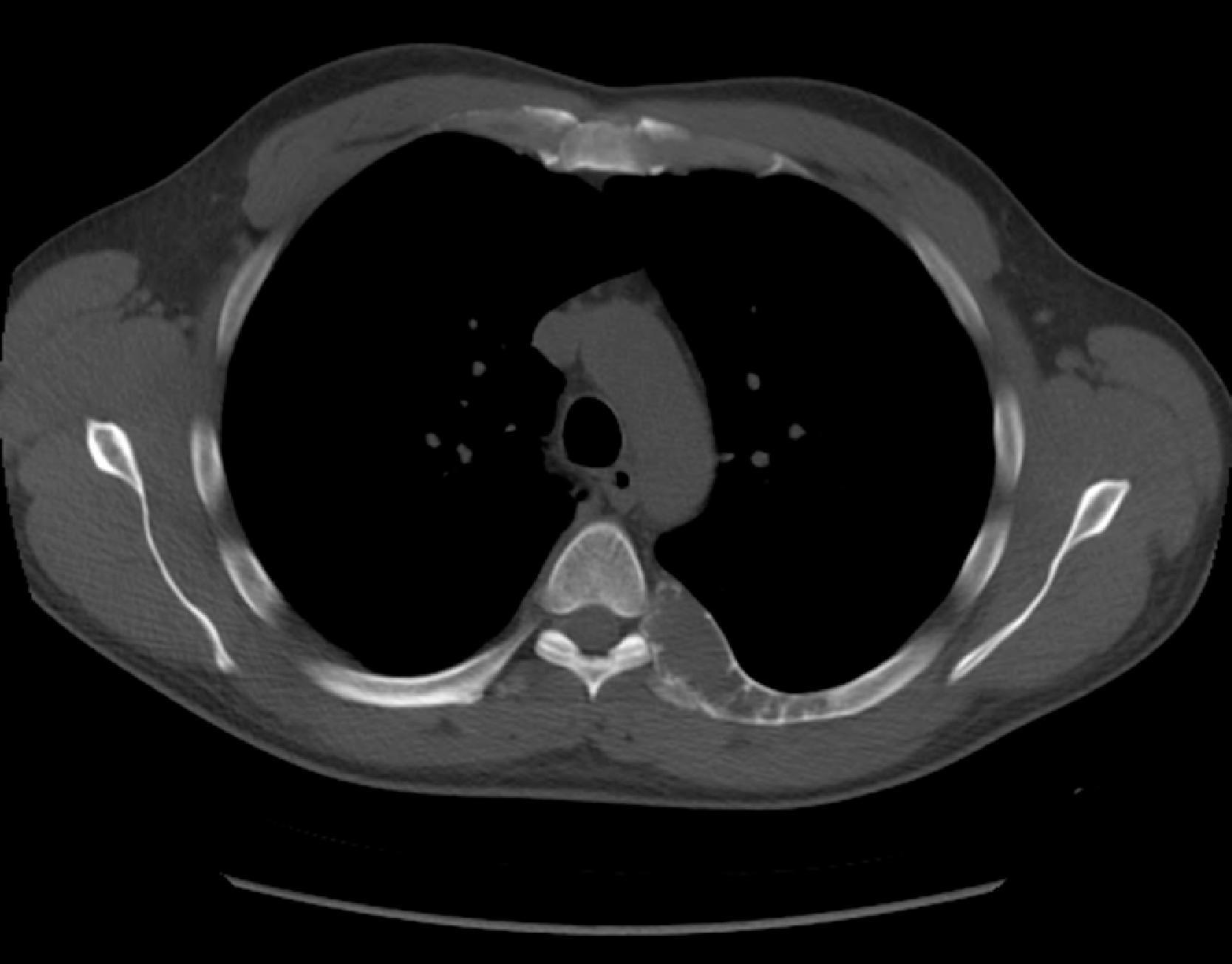
A benign bony lesion that typically presents in the third decade of life, an osteochondroma classically involves the costochondral junction. This lesion can present either as a small, palpable, painless mass or can grow to a larger size when unnoticed within the chest cavity. Punctate central calcifications with a mineralized hyaline cartilage are characteristic radiologic findings of osteochondroma. Observation with serial imaging is appropriate when lesions are small and asymptomatic. Symptomatic or enlarging lesions can be resected with local excision. Although malignant degeneration is rare (less than 1% of patients), resection should be considered if cartilage thickness exceeds 2 cm; malignant transformation to chondrosarcoma or osteosarcoma has been reported.
Chondromas are benign cartilaginous tumors that originate from the medullary cavity. They are more commonly found anteriorly in the rib and have no gender predilection. They present either as a painless mass or an incidentally documented lesion on imaging. On chest radiograph, chondromas are characteristically osteolytic lesions with well-defined sclerotic margins. On CT or MRI, punctate calcifications and cortical scalloping may be seen. These benign lesions are often difficult to differentiate from low-grade chondrosarcomas (both radiographically and histologically) and therefore should be resected with wide local excision.
Chondrosarcomas are the most common primary malignant chest wall tumor ( Fig. 2 ). They occur most frequently in the fourth to seventh decades of life and are slightly more common in men than in women. They are typically located anteriorly and involve either the costochondral junction or the sternum. On imaging, irregular margins and bony destruction are typical. Early-stage lesions can retain a thickened cortical cap, whereas more advanced tumors progress to complete cortical destruction and an associated soft tissue mass. Suspected benign chondromas in which the cortical cap thickens over time may be in the process of malignant degeneration into chondrosarcoma. All suspected chondrosarcomas should undergo wide local excision; they often require chest wall reconstruction. Poor prognostic factors include hypercellularity, cytologic atypia, high mitotic index, and larger tumor size. High-grade tumors have a 75% chance of distant spread at the time of diagnosis. Because these tumors respond poorly to chemotherapy or radiation, complete surgical excision is the primary treatment modality. Studies demonstrate that inadequate resection margins in chondrosarcoma are associated with significantly higher local recurrence and lower overall survival.
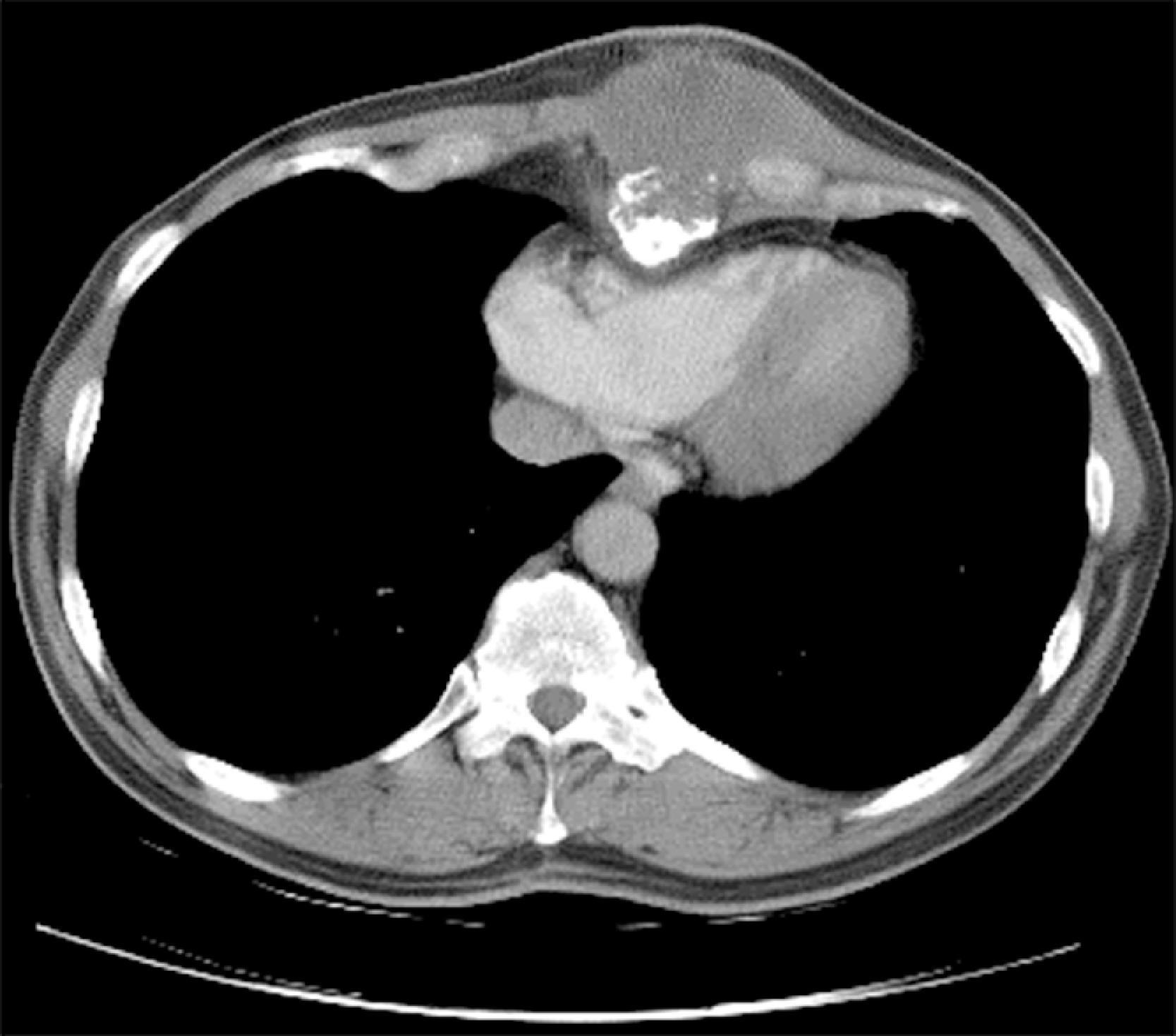
Osteosarcomas of the chest wall have a bimodal presentation, with most cases occurring at puberty but with a secondary peak after 40 years of age. They present as a rapidly expanding mass and arise from the rib, scapula, or clavicle. Environmental factors (fluoride exposure, farmworkers) and genetic predisposition (young age at puberty, familial history, retinoblastoma, Li Fraumeni syndrome) increase the lifetime risk of development of osteosarcoma. Radiographic findings include bony destruction with an associated large, heterogeneous mass composed of necrotic tumor and hemorrhage and often punctate calcification. Because distant metastasis (typically to the lung) is common and good systemic options for therapy exist, complete staging with PET/CT imaging and biopsy for tissue confirmation is indicated for suspected osteosarcoma. Induction chemotherapy followed by surgical resection (wide local excision with reconstruction as needed) is the treatment of choice for localized disease. Overall 5-year survival rates have increased to 60% when the osteosarcoma is localized but remains below 30% in patients with distant metastases.
Ewing sarcomas and primitive neuroectodermal tumors (PNETs), also known as Askin tumors, are malignant, small, round cell tumors with genetic translocation between chromosomes 11 and 12. They typically occur in children and young adults and are almost exclusively seen in Caucasians. Around 15% of Ewing sarcomas and up to 5% of PNETs arise in the chest wall and can involve a single rib, clavicle, or the scapula, in descending frequency. They often present as a painful enlarging chest mass with constitutional symptoms that include fever, weight loss, and generalized malaise. Associated pleural effusions are also common. Radiographic findings include a large, noncalcified mass with bony destruction. As with osteosarcomas, systemic disease at diagnosis is frequent and staging with PET/CT and consideration of neoadjuvant systemic therapy followed by complete surgical resection and chest wall reconstruction is warranted. Postoperative radiation should be reserved for a margin-positive resection. Bilateral whole-lung irradiation may be used in the adjuvant setting to increase event-free survival in patients with documented pulmonary metastases. Overall 5-year survival rates for Ewing sarcoma can approach 70%, whereas for PNETs, long-term survival remains about 30%.
Plasmacytomas tend to occur in men in their 60s and 70s and present with pain, typically without a palpable mass. Imaging documents a punched-out osteolytic lesion of the bone. The role of surgery in these patients is generally limited to obtaining tissue for histologic diagnosis. After tissue diagnosis is confirmed, local therapy with radiation is indicated. Up to two-thirds of patients will develop systemic involvement with multiple myeloma, which carries a 5-year survival rate around 35%. However, solitary plasmacytomas that are successfully irradiated and do not progress to systemic multiple myeloma have an excellent long-term prognosis, with over 90% 5-year survival. Surgical resection as local therapy for isolated disease can be indicated for patients in whom radiation therapy is not an option.
Chest wall lipomas are typically larger and deeper than those soft tissue lipomas found in other anatomic locations. They are rarely symptomatic. Imaging reveals a homogenous mass consistent with mature fatty tissue. Resection is only indicated for symptomatic or enlarging lesions or for suspicion of a low-grade liposarcoma.
Desmoid tumors arise from fibroblasts deep within the chest wall musculature and often occur in patients in their teenage years to early 30s. They present as a slowly growing, sometimes painful mass, often in the context of prior trauma or prior thoracotomy; they are also sometimes seen in the context of systemic fibromatosis (Gardner syndrome). Complete surgical resection with wide margins (up to 4 cm if possible) with chest wall reconstruction is the optimal therapy. Local recurrence rates are quite high; adjuvant radiation therapy can be used both prophylactically and in the context of microscopically positive margins. Recurrence rates for margin-positive disease remain as high as 90%, even with radiation therapy.
Hemangiomas of the chest wall are benign proliferations of blood vessels that form in the context of muscle, rib, or subcutaneous tissues. They are most typically seen in children, and MRI or ultrasound can be used to confirm the diagnosis. Resection is only indicated if symptoms develop; bleeding, ulceration, and (rarely) heart failure from arteriovenous malformation and shunting (cavernous hemangiomas) can occur. In these cases, local excision is curative, with chest wall reconstruction reserved for larger lesions.
Chest wall schwannomas are encapsulated tumors that develop from intercostal nerves or thoracic spinal nerve roots. They are typically asymptomatic and identified incidentally during thoracic imaging. CT and/or MRI are usually sufficient for diagnosis and, in asymptomatic cases, serial imaging and observation suffice. Needle biopsy can be confirmatory in cases of diagnostic uncertainty. Resection is reserved for symptomatic or enlarging lesions and may require contiguous chest wall or vertebral body resection and reconstruction.
Malignant fibrous histiocytoma (MFH) has a bimodal distribution at diagnosis, with peaks at 20 to 30 years of age and 50 to 60 years of age, with the latter being more prevalent. These tumors rarely arise from the chest wall; when they do, they are generally associated with prior radiation exposure. Imaging reveals a heterogeneous mass with irregular borders; bony involvement is rare. A well-planned needle biopsy for tissue diagnosis is indicated for MFH with induction chemotherapy followed by surgical resection and reconstruction being the therapy of choice. Postoperative radiation can be reserved for margin-positive disease. Even with complete resection and systemic therapy, metastatic disease is common, and 5-year survival remains less than 50%.
These malignant tumors rarely present as a primary chest wall malignancy, and the thoracic surgeon is more typically involved with the management of oligometastatic lung involvement from systemic disease. Nevertheless, primary synovial cell sarcomas of the chest wall can occur, typically in early adulthood. Imaging generally reveals a mass with heterogeneous foci resulting from necrosis or hemorrhage within cystic components, with about one-half of the tumors showing calcification. Treatment includes complete surgical resection, with chemotherapy or radiotherapy being utilized in either the neoadjuvant or adjuvant setting. Five-year survival remains around 50%, irrespective of the timing of chemoradiotherapy.
Rare in adults, rhabdomyosarcomas are the second most common malignant primary chest wall tumor in children. As the vast majority of cases present with distant metastases, complete staging should be undertaken to determine which patients are candidates for primary site resection. Staging in children can include CT scan of the thorax, abdominal ultrasound, and bone scan, although PET/CT scans are being used increasingly in the pediatric population. Tissue confirmation is important because, when resectable, these aggressive tumors are treated with induction chemoradiation followed by wide local excision with chest wall reconstruction. Sometimes adjuvant chemotherapy or radiation are also indicated. Survival remains poor with surgical resection alone; however, trimodal therapy has resulted in a significant improvement in 5-year survival, with rates as high as 75% in patients without documented metastatic disease at the time of diagnosis.
Become a Clinical Tree membership for Full access and enjoy Unlimited articles
If you are a member. Log in here